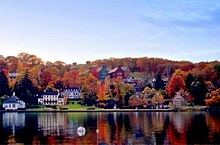Franklin Hooper
Franklin William Hooper | |
|---|---|
Brooklyn Institute of Arts and Sciences, Brooklyn Museum |
Franklin William Hooper, LL.D. (11 February 1851 – 1 August 1914) was an American biologist, geologist, educator and institute director.
Life and work
He was born in Walpole, New Hampshire, the son of William Hooper and Elvira Pulsifer Hopper, and grew up on his parents' farm. After local schooling he studied at Antioch College, Yellow Springs, Ohio, from 1867–1871, and in 1872 enrolled at Harvard University to study biological sciences, where Louis Agassiz and Asa Gray were among his professors. He participated in the first biological summer school at the short-lived Anderson School of Natural History, founded by Agassiz in 1873 on Penikese Island, Cape Cod.[2] After graduating with a B.A. in 1875 (Hon. M.A. 1897) he worked for the Smithsonian Institution to study algae and coralline formations in the Florida Keys.[3]
After three years as head of the high school in Keene, New Hampshire, from 1877-1880, he was appointed professor of chemistry and geology at Adelphi College, Brooklyn, where he taught until 1889.[3] He was the first president of the Brooklyn Ethical Association 1881–1883.[4]

In 1889 he was appointed as General Director of the revitalised

Hooper greatly expanded the institute's work of presenting a wide range of public lectures and concerts, quadrupling its membership. One of the regular visiting orchestras to play at the institute was the Boston Symphony,[5] whose founder married Agassiz' daughter.
The Brooklyn Museum will embrace all known human history, the infinite capacity of man to act, to think, and to love, and the many departments of science and of art which he has developed. Through its collections and its libraries it should be possible to read the history of the world.
Franklin Hooper, at the laying of the cornerstone of the Brooklyn Museum, 1895[6]
Under his leadership the institute's art and architecture departments were set up, leading to the competition to design the Brooklyn Institute's new museum (now the
In 1904 Hooper was one of the founders of the American Bison Society with Ernest Harold Baynes.[9] At his suggestion Baynes wrote to President Theodore Roosevelt, who became the society's first Honorary President. Hooper also suggested the inclusion of the Premier of Canada, Earl Grey, as an officer of the society.[10][11] Hooper himself became the society's president in 1911.
Along with Hal B. Fullerton[12] he was the main impetus behind the establishment in 1912 of the New York State School of Agriculture on Long Island.

He was instrumental in setting up the Old Rockingham Meeting House Association in 1911, for the continued preservation of the newly restored Vermont church which his great-great grandfather David Pulsipher had helped to found in 1778.[13]
Hooper's obituary in the
His bust by Edmond Thomas Quinn is at the Brooklyn Museum.
Family life
He married Martha Holden of
Martha Hooper was vice-president of the Brooklyn Institute's Domestic Science department in 1909. They had three children: Rebecca L. Hooper, born in Walpole, March 23, 1877, married William H. Eastman in July 1912;[15] William S. Hooper, born in Keene, New Hampshire, June 1880; and Franklin Dana Hooper, born in Brooklyn, New York, October 30, 1883.
Death
Hooper died August 1, 1914, in his family home in Walpole, New Hampshire[1]
References
Citations
- ^ a b Brooklyn Daily Eagle Almanac. Brooklyn Daily Eagle. 1915. pp. 607–.
- ^ a b Watson 1991, p. 20-23.
- ^ a b Cavaioli 2009.
- Popular Science Monthly. 42: 672–3.
- ^ Cooke 1904.
- ^ "Connecting Cultures: A World in Brooklyn". Brooklyn Museum.
- ^ Steffensen-Bruce 1998, p. 160.
- lantern slides was distributed to the Museum, the Children's Museum, and the Botanic Garden. Brooklyn Museum archives
- ^ Where the Buffalo roamed... The story of Baynes' preservation of bison.
- ^ Am. Bis. Soc. 1908, p. 1.
- Carnegie Institution, situated next door.
- ^ Fullerton 1912.
- ^ Hayes & Hayes 1915, p. 59.
- ^ Hayes & Hayes 1915, p. 60.
- ^ New York Times, 3 July 1912
Sources
- Annual report of the American Bison Society, 1905 - 1907. American Bison Soc. 1908.
- Cavaioli, Frank J. (Fall 2009). "Chartering the New York State School of Agriculture on Long Island". Long Island History Journal. 21 (1). ISSN 0898-7084. Archived from the originalon 2012-07-30.
- Cooke, James Francis (September 1904). "The Brooklyn Institute of Arts and Sciences - Its Musical Work". The Etude.
- Fullerton, Edith Loring (1912). The lure of the land. The history of a market-garden and dairy plot developed within eight months upon Long Island's idle territory... (4th ed.). Long Island, New York: Long Island Rail Road Company.
- Hayes, Lyman S.; Hayes, William D. (1915). The old Rockingham meeting house, erected 1787 and the first church in Rockingham, Vermont, 1773-1840 (illustrated ed.). Bellows Falls, Vermont.
{{cite book}}: CS1 maint: location missing publisher (link) - Steffensen-Bruce, Ingrid A. (1998). Marble Palaces, Temples of Art: Art Museums, Architecture, and American Culture, 1890-1930. ISBN 9780838753514.
- Watson, Edith L. (1991). Houses for Science: a pictorial history of the Cold Spring Harbor Laboratory. CSHL Press, 1991. ISBN 9780879694036.
External links
- A Brief History of The Brooklyn Institute of Arts and Sciences, Part I and Part II at The History Box
- Bust of F. W. Hooper by Edmond Quinn, in the Brooklyn Museum
- Franklin W. Hooper's obituary, New York Times, 2 August 1914
